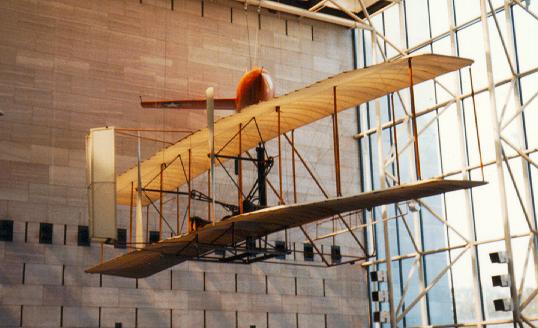

When Orville became ill with typhoid, Wilbur nursed him back to health. While taking care of his
sick brother, Wilbur read an article about a german glider pilot which piqued his interest in flying.
He then wrote to the Smithsonian Institution for information about aeronautical research. Wilbur was
the first to realize that the flying machines needed to be controlled in all three axes of motion.
These axes of pitch, roll, and yaw would allow for complete control of a flying machine. Wilbur saw
that by twisting the ends of a wing he could change the direction of a kite he was experimenting with.
This action of twisting the end of the wing was called wing warping. The same method in fact that
a bird uses to control it's flight in a glide.
In August of 1900, Wilbur built his first glider. From infomation he had requested from the U.S. Weather
Bureau he had decided that a good location for flying his glider was a remote sandy area off the coast of
North Carolina called Kitty Hawk. Wilbur and Orville then took a trip to Kitty Hawk to test the glider.
The next year they returned and tested an improved glider that had a twenty two foot wingspan.
They returned to Dayton to begin working on an engine and propeller for the flying machine. They checked
all of the motor manufacturers to see in any could build them an an engine that could produce eight
horsepower and weigh less than two hundred pounds. None were interested in building a single engine
from scratch for this odd adventure or were not capable of spending the time for a single engine. Having
designed a propeller with the same principles they used to design their wings, Wilbur and Orville then built
their own 4-cylinder, 12-horsepower engine that weighed only one hundred and thirty five pounds. They built
the 1903 Flyer in sections in the back room of their bicycle shop at 1127 West Third St. in Dayton. When
completed, it was shipped down to Kitty Hawk and assembled.
On December 17, 1903, Wilbur tried to fly the machine first but stalled it on takeoff. The brothers then
flipped a coin to determine who would pilot the machine next. Orville won the toss. At 10:35 a.m., he made
the first heavier-than-air, machine-powered flight in the history of the world. In a flight that lasted only
12 seconds of just 120 feet, Orville did what men and women had only dreamed of doing for centuries.
The airplane was flown three more times that day, with Orville and his brother Wilbur alternating as pilot.
The longest flight of the day was with Wilbur at the controls. He managed to fly 852 feet for a duration of
59 seconds. Three times farther than the original flight.
The flying machine, dubbed the Wright Flyer, is now on display at the Smithsonian Air and and Space Museum in
Washington, D.C. The specifications of the Flyer are as Follows:
WRIGHT 1903 FLYER
The 1903 Flyer was constructed of wood (spruce and ash) covered with muslin. The wooden framework "floated"
within fabric pockets sewn inside, making the muslin covering an integral part of the structure. This ingenious
feature made the aircraft light, strong, and flexible. To fly the airplane, the pilot lay prone with his head
forward, his left hand operating the elevator control. Lateral control was achieved by warping the wing tips in
opposite directions via wires attached to a hip cradle mounted on the lower wing. The pilot shifted his hips from
side to side to operate the mechanism, which also moved the rudder.
Design Features:
Wingspan: 12.3 m (40 ft 4 in)
Length: 6.4 m (21 ft)
Height: 2.8 m (9 ft 3 in)
Weight, empty: 274 kg (605 lb)
Engine: Gasoline, 12 hp
Manufacturer: Wilbur and Orville Wright, Dayton, Ohio, 1903
There exist literaaly hundreds of internet sites where information, photos and even movies can be viewed of the
Wright Brothers and their achievements. A couple of locations are listed for your pleasure. These sites were used
as the primary source of this paper.